
Solas VR CEO and Creative Director talk on Engage.



The short answer is yes.
As we have already discussed in a previous blog post, the Covid-19 pandemic raised an unprecedented wave of burnout and emotional instability symptoms as a response to the loss of control and insecurity. As the world around us is changing, we need to find new anchors that will redefine our ruined safe zone. The war in Ukraine intensified these feelings and, now, more than ever, the impact on employees’ productivity is obvious; lack of concentration, irritability, a cynical approach to goals etc. Insecurity is promoted to a business problem.
There is a vivid discussion amongst managers on how to cope with this new status before it explodes. And, there is a consensus for a two tiers approach:
Transformational leadership is the best approach for turbulent times: managers need to be empathetic, flexible and humane so that their team members will feel safe to express their feelings and fears. There is no room for “This is not my problem” behaviours, as distancing from employees becomes a source of extra insecurity. The empathetic leader is open to new working conditions- eg WFH- allows some personal space or/and time off for psychological issues, remains patient and approachable. And, what is now a new tool in the toolbox, managers can encourage their team members to care for their mental health, through discussion, visitations to consultants and mindfulness.
On the other hand, employees need to acknowledge the challenge and try to focus on its source. Psychologists insist that throughout our lives we strive for this sense of control- from the first day of our existence as humankind. We have been trying to rationalize natural phenomena, we built huge buildings to come closer to God, we make decisions that secure the boundaries of our safe zones. And yet, lately, two devastating events shook all our beliefs. The pandemic made “healthy” our salient identity and the war underlined how fragile our world is. What we need is something we can lean on and this is always found within ourselves.
Here comes mindfulness, as the solution to these urgent problems. Either as employees or as individuals, now we need to create some space between the world out there and the world inside us. Our thoughts are just thoughts, they do not determine our lives. Our emotions will go away if we sit with them. These techniques seem easy- in fact, they are- but guidance is called for.
We, hence, understand why Solas VR mindfulness app becomes every day more popular amongst corporations as the solution to keep employees close to the team yet working on their inner balance is now a strategic goal.

There has been a lot of discussion about the after Covid-19 era and how businesses will need to adopt and adapt as society and value systems change. This pandemic is expected to define a whole generation, the way 9/11 did, as a deep shock in terms of what we thought it was given.
The corporate world has been challenged, also. Remote working, grieving employees, stakeholders, at large, that didn’t care about consumption while their world was falling apart.
Now that the storm calms down, managers and CEOs are called to revisit their priorities and practices. As Hubert Joly, former CEO of Best Buy recently put it: “The profound multifaceted crisis we are facing has made it even more obvious that business and society cannot thrive if employees, customers, and communities are not healthy.” But, as we were forced to learn during the previous year, health is not only about fever and cough; stress levels and burnout incidents skyrocketed and a massive explosion of depression diagnoses is expected in the near future. Humans reached their psychological and emotional limits as they experienced, many of them in first hand, the harsh reality.
These voices preaching about the value (or even necessity) of mindfulness as a habit are finally heard. Each one of us needs to find some inner peace that will become the fuel and the refugee in this effort to cope with the new reality. Taking some time off- even some minutes off- letting the noise go and focusing on our mere existence through breathing can restore our faith to life and make every day easier. At work, corporate wellness practices emerge as higher priorities, as security empathy and understanding are becoming key leadership practices.
What we read, what we learn and what we believe converge at this: we (as members of a society) have given far too much attention to what happens outside. Now it’s time to take care of our minds and souls and find new (or very old) ways to cure our wounds. After all, there is always a calm, safe place in our minds. Perhaps now it’s the time to visit it.
Photo by Artem Beliaikin on Unsplash
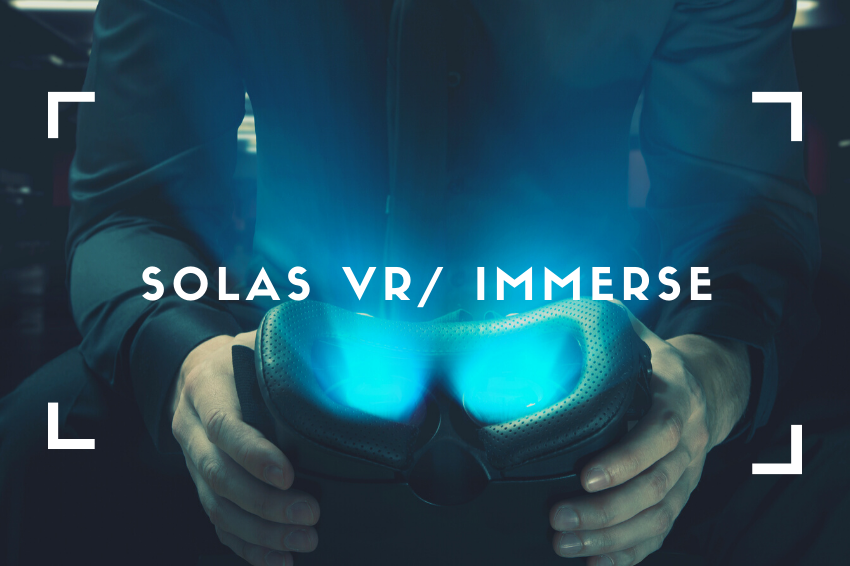
Wednesday 7th April, London- Press Release
Enterprise virtual reality (VR) software provider Immerse has today announced its new partnership with Solas VR, a leading meditation app. This partnership will enable organisations to access a library of VR meditations that can be easily integrated into the Immerse Platform and deployed to employees across organisations.
Virtual Reality is enhancing human performance in ways that were once unthinkable. Today, it is transforming the way we learn, explore and interact. With a global customer base and customers such as DHL, Nestlé and bp, the Immerse Platform creates an all-in-one solution for enterprise organisations. This partnership is part of an ongoing initiative from Immerse to build an ecosystem where the Immerse Platform will empower and enable organisations to embrace the future of training in the workplace.
The past year has been particularly challenging not only for businesses but workforces too. Mass homeworking has left employees struggling to maintain a healthy work-life balance, with the additional stress of the pandemic bringing its own challenges too. Solas VR has developed an innovative meditation app to boost mental wellbeing and brain productivity through meditation, which will be hosted on the Immerse Platform. Drawing from solid scientific data and empirical studies, this synergy aims to multiply the effectiveness of training, through better focus and open-mindness, achieved via mindfulness. The partnership will empower organisations to enhance employee engagement and performance, providing a new approach to mental health and job satisfaction.
The initial library of Solas VR experiences to be made compatible and available through the Immerse platform include:
Tom Symonds, Immerse CEO comments: “The Immerse team are excited to be working with Solas VR to help encourage mindfulness in the corporate environment. We understand the importance of having a healthy and happy workforce, and the capabilities of virtual reality will allow those who receive the content to incorporate it more effectively than traditional methods. Partnering with Solas VR is a great step in our endeavour to enable businesses to capitalise on the opportunity offered by immersive technology in multiple ways.”
Stephen Pitcher Managing Director at Solas VR adds: “We’re very excited to be working with Immerse to help bring meditation, and subsequently a better sense of wellbeing, to as many people as possible. The last year has been difficult, but employers who prioritise corporate mindfulness will gain a sustainable competitive advantage as looking after your employees is more important than ever.”

If being mindful means understanding our thoughts and emotions here and now, then when our thoughts and emotions are negative we get to feel them more, right? And, if this is the case within a work environment, that means that unhappy, unsatisfied employees will feel these emotions multiplied? A recent research supported that this can be the case, indeed. In a sample of 1700 employees, they found that for employees whose jobs frequently required them to display inauthentic emotions, greater levels of mindfulness consistently led to lower self-control and lower overall performance.
This is important, right? It is like being mindful surfaces the blunt truth, whether we like it or not- but, since the benefits of mindfulness at work are solidly backed up, we are called for to find new ways to face this truth. Some voices support that we could target our mindfulness training towards employees that have relatively low demands for faking emotions- excluding immediately all first line employees. Obviously, this doesn’t solve the problem, it just hides it under the table. First line employees are the ones under ultimate stress and they need new way to let some steam off and remain calm and balanced. Disqualifying them from mindfulness is like punishing them for the job they have chosen and condenming them to eternal stress and ultimate burnout.
The road to the truth is, as always, longer and more demanding. Mindfulness practices, according to the same researchers should focus on “deep acting — that is, the practice of actually changing how you feel to match the needs of your organization — can be an effective strategy for displaying the required emotions without negatively impacting job satisfaction and wellbeing. For example, nurses tasked with unpleasant and tiring work might focus on their patients’ experience and imagine the pain and fear their patients may be feeling, inspiring compassion instead of frustration.” This mindset is helpful for everyone, it turns negativity into meaning and it can contribute in lower burnout rates. From this perspective, the key to the new way of thinking is mindfulness itself: through training and culture, managers should invite their teams to face their true emotions and work on them until they are converted into aspiring thoughts. The purpose of humans- even at work- is to find meaning in everything. Let’s do it, then.
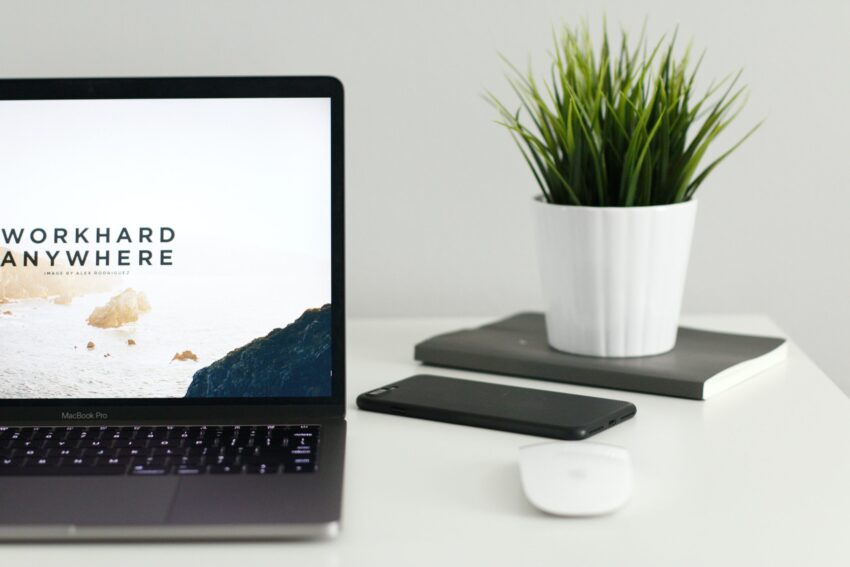
It is amazing how quickly VR training became popular and it tends to become a mainstream solution for businesses. Starting from hard skills training, and expanding to soft skills, the VR experience changes the game in training performance. The image brings together the most important findings an extensive PWC case study on the application of VR techonoly in training in general and in soft skills training in particular.

What we also know well, from dozens of scientific publications, is that meditation, breathing excercises and mindfulness clear the mind and boost focus and concentration. When these are applied on a training environment, it is only natural that trainees will be more receptive to knowledge, more focused and eager to accept new concepts. This is how we decided to team up with VR training platforms, in a synergy based on the power of VR technology, enhanced by the power of an open, focused mind.
Download our fact sheet for more information and stay tuned for our updates!
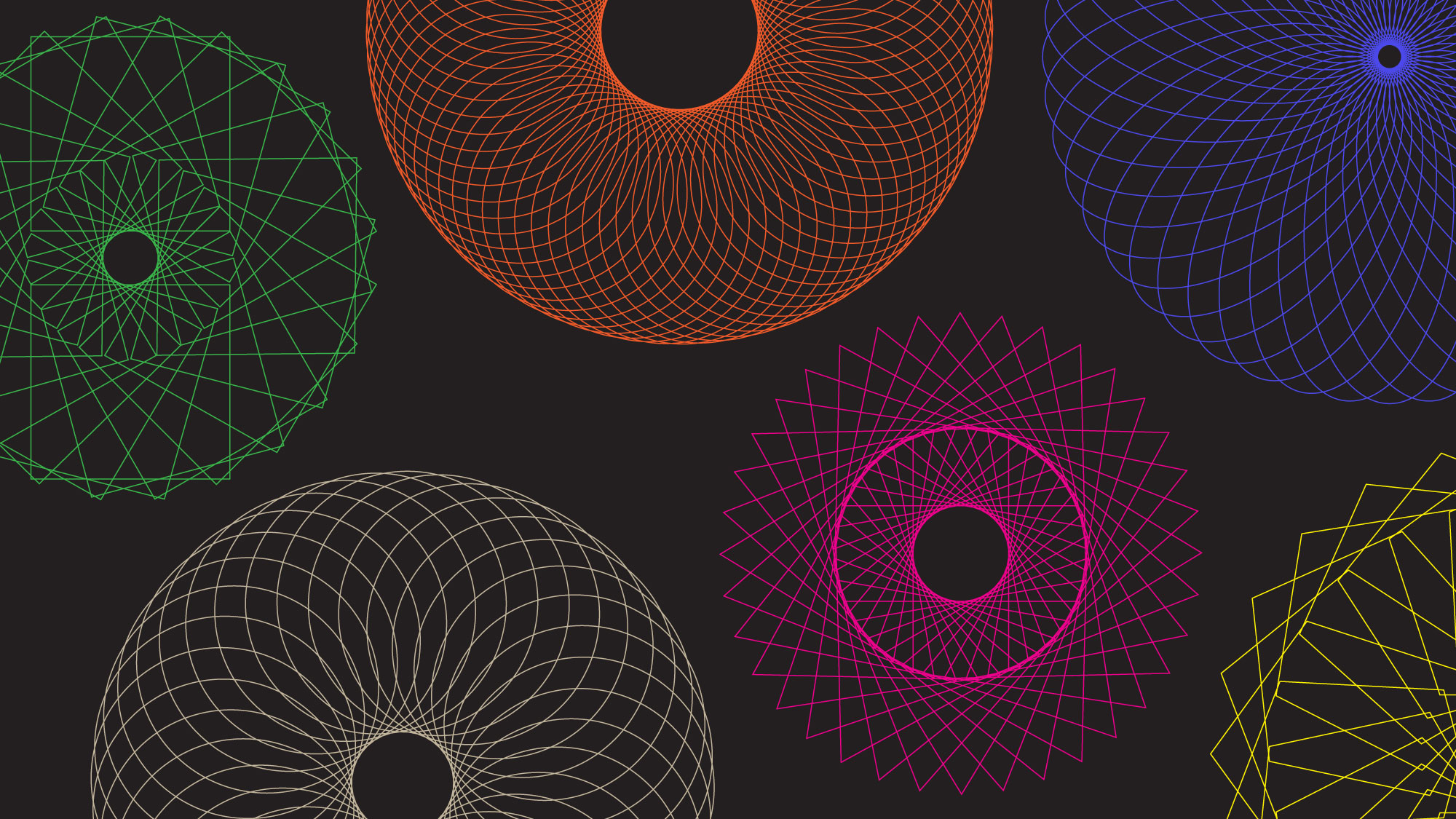
This article is taken from HBR.org
It’s no surprise that online work is depleting our energy and resilience. The evidence shows that many of us are working longer hours, suffering chronic stress, and burning out at levels the world has never witnessed. At the same time, we’re longing for and losing our social connections and sometimes experiencing profound loneliness and grief in solitude. To regain energy, find renewed pleasure in our work, and truly connect with colleagues and friends, we need to find ways to block out the noise in our virtual reality.
One way we can do that is through cultivating mindfulness — online.
Mindfulness is the choice we make to be present in the here and now: This moment, in this meeting, with this person or group of people. Research shows that most activities of our working lives, from working on an independent task to team meetings and one on ones, benefit from being conducted with mindfulness. By pausing, checking in with others, or starting meetings with a few moments of meditation or reflection, stress levels drop and we feel more connected to our purpose and to others in the room. We listen better and feel happier.
But how can we be mindful in an online working world? How can we be truly present for others when we couldn’t be (physically) farther from one another?
What we learned from 2020 is that online and remote working doesn’t have to be a barrier to our capacity to deliver leadership presence, empathize and connect with colleagues, and build strong workplace communities. Contrary to popular misconceptions, you don’t have to retreat to a mountain top or a meditation cushion to practice mindfulness. You can do it while working from home by:
You can apply these three principles of mindfulness to managing and leading online.
From doing to being: Offer your presence. Action is the hallmark of managers. It’s what they’re noticed for and measured on: Doing, achieving, producing, organizing, controlling. New remote and hybrid working environments have thrust managers into excessive patterns of “doing.” But sometimes, who and how you’re being can be more important than your actions.
To cultivate trust and motivate and inspire others, pay attention to how you’re being with them. Are you rushed or distracted? Is your mind on the next meeting or your to-do list? To enhance the quality of your leadership presence with others, take a moment to reflect on your physical and emotional state when entering a new meeting. Through your virtual presence, what energy will you convey to this set of colleagues or clients? Will you bring the tough conversation you just had with someone else into this new one? Will you offer a sense of calm and reassurance?
Another’s presence (or lack thereof) is noticeable. When someone is speaking, are you using the moment to check your email, send a text, or schedule a meeting? You may think that none of this shows in online working contexts. But just as in a face-to-face meeting room, virtual participants know whether and how you’re truly present with them — emotions and attention can be broadcast, felt, and contagious across virtual boundaries. Even in a big online town hall, the audience can sense if the speaker is truly with them, and the speaker knows if most of the audience is elsewhere.
Lead by example when working remotely. Try to have your camera on and ask others to do so if possible. Ensure others can feel your presence by establishing eye contact, and use your body and posture to convey interest and empathy. If you know you just can’t help but look, turn off those enticing email notifications.
Shifting your focus to how you’re being doesn’t mean that things don’t get done. And none of these shifts in your awareness and attention take more than a few moments. But they do have impact on you and on those you’re working with.
From future to present: Be here, now. Managers are taught to relentlessly plan for the future. Yet always having your mind on next month’s targets or next year’s profits can mean you miss life today. You forgo important opportunities for connection and empowering others if you’re in your mind, planning “the next step” or worrying about something that might not happen.
Take a moment to step back from the busy-ness and view your tasks with perspective — looking down from the balcony. What or who is important right now? Ask yourself: Am I postponing life, thinking that all the good stuff will come next month, next year, or when lockdowns and pandemic restrictions end? Postponing life can exacerbate unhappiness and stress. We hold out for when things will improve but don’t see all the beautiful small things around us now: A fun meal with family, a morning walk or run, the sharing of a special moment or a celebration with colleagues.
Next time you’re in a virtual meeting and notice your mind has wandered off, catch yourself. Bring your mind to where your body actually is — this present moment, right here, right now. Take a few seconds to anchor your awareness in the now by drawing on your senses. Look outside if you can, and take in any sky or green that may be visible. Relax your shoulders and your jaw. Breathe out. These momentary connections with your physical senses are the gateways to being more present. Sharing some words of gratitude for people showing up and for what exists in the here and now can help others to pause and pay attention. They may notice they’ve been ruminating and can choose to tune in, not tune out. Practicing mindfulness techniques like these has been demonstrated to lift moods, foster well-being, and improve overall psychological health.
From me to you: Enabling connection and community. When people are talking, where is your mind? Is it with them? Or are you waiting for a gap to jump in with your opinion or experience? Can you suspend your own agendas and ego needs to hear what people on the team need? Try deepening your listening. Try listening without wanting to “fix” people or (perhaps silently) insisting they get over things. Deep listening is generous. Encourage the person speaking to discover and voice a way forward. They will appreciate and be empowered by it, finding their own path or solution.
In our executive development work, we have found that virtual meetings can reduce barriers for people to speak and to have their voice and presence heard and felt. For example, tools like “raise hand” indicators and simultaneous chat functions enable different ways for people to offer insight and signal their contribution. Further, that everyone has one equal-sized window with only a headshot in a virtual meeting can diminish stereotypes, hierarchies, and power differentials as certain physical and status markers are removed. As a mindful leader, be aware of who is present, and pay particular attention to inclusion. Welcome and seek people’s input, especially from those who usually don’t say much.
Endorsing expressions of openness and vulnerability can help cultivate a culture of appreciation and psychological safety. As a leader, you might offer some vulnerability about where you are right now, which will open the space for others to express how they really are. You might be juggling the needs of a sick child or a parent in aged care. The circumstances of online working have sometimes meant we’ve had to get more real. People are tuning in from their living rooms and bedrooms. They have families, pets, and other competing needs to accommodate. We’ve had to take off our office masks, our make-up, and our constructed work identities and allow others to see us more fully. This has surely been a good thing.
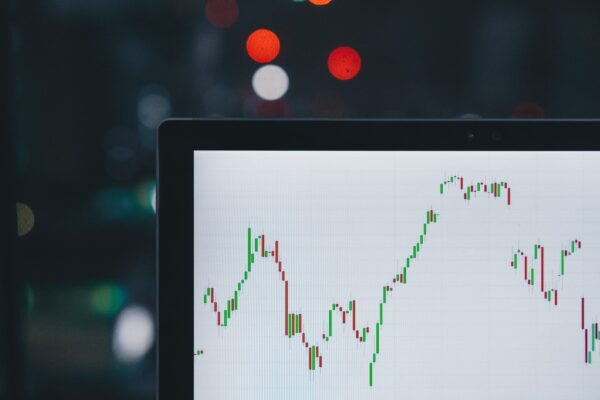
There is compelling data on the importance of stress management at work; the current situation and the widespread uncertainty not only the don’t relief stress but they prove to add up to already high burnout ratios. We have brought together some numbers you need to know, about the silent killer of team productivity.
80% of workers feel stress on the job and nearly half say they need help in learning how to manage stress. 42% say their co-workers need such help. – American Institute of Stress
Stress levels in the workplace are rising with 6 in 10 workers in major global economies experiencing increased workplace stress. With China (86%) having the highest rise in workplace stress. – Regus Group
Employee burnout accounts for 20-50% of their companies’ annual employee turnover. – Kronos & Future Workplace
Meditation increases employee productivity by 120%. – National Business Group on Health
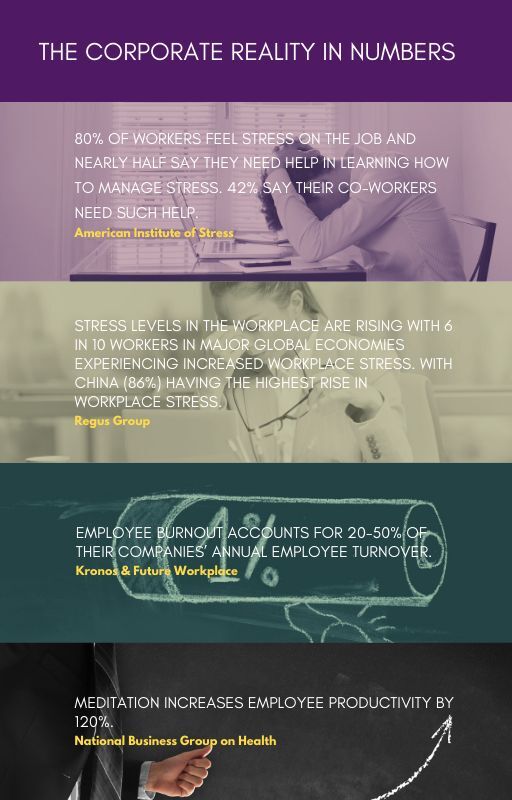
Download our free e-book on corporate mindfulness and allow your team to be more.
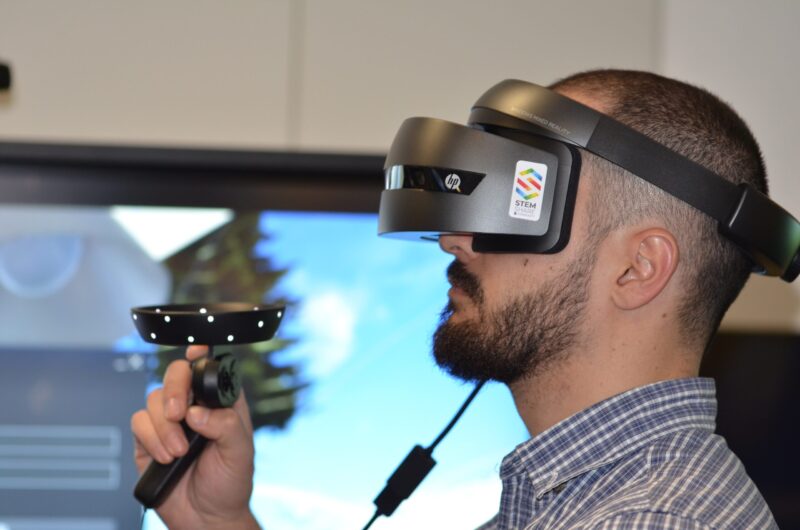
Developments in VR technology have been remarkable: new technologies, new applications and a strong interest from health professionals, researchers and academics have put VR at the core of research activity.
What we know so far is that Virtual Reality supports learning and boosts memory, helps in chronic pain relief as well as being highly successful for PTSD treatment. As a part of our e-book, we primarily reference academic resources that report results from experiments, with a focus on mindfulness and how VR impacts the brain. There is a broad consensus that VR enhances the meditation experience through content that allows the mind to focus and unwind – like the 360 cinematic videos on the Solas VR app. This can be understood through the fundamental brain biology: as thoroughly explained in a 2019 publication (Neuroscience of Virtual Reality: From Virtual Exposure to Embodied Medicine) the brain and VR technology share the same basic mechanism: embodied simulations, meaning representations and predictions of the self in the environment. Simply put, as the brain prepares itself to react to different environments by imagining them, VR provides the mind with these environments in an artificial way. Additionally, according to a Forbes article, “Meditation, coupled with VR technologies, can be more precise and personalized and make the learning curve easier. Plus, when wearing a headset you are truly transported, making it easier to tune out of any distractions around you and focus”.
Employers are facing a dilemma: Their workforce needs to learn new skills, upgrade existing capabilities or complete compliance training, but may not be able to do so in person given the current environment. Yet, training is especially important now, with employees to keen to gain skills, and it may become even more critical when workers start returning to a changed workplace. So how can employers deal with the challenge? The effectiveness of Virtual Reality in hard skills training has been established for some time now, with the use of simulators for pilot training for example. But, there is now equivalent findings for the case of soft skills, so PWC run an experiment: they conducted the same training program (inclusive leadership) in three different learning modalities: classroom, e-learning, and VR training and they monitored the results in terms of the the process effectiveness and the training outcomes. What they found builds a new case on the use of VR in soft skills training:

VR training is 4x faster than classroom training. What took two hours to learn in the classroom could possibly be learned in only 30 minutes using VR. When you account for extra time needed for first-time learners to review, be fitted for and be taught to use the VR headset, V-learners still complete training three times faster than classroom learners.
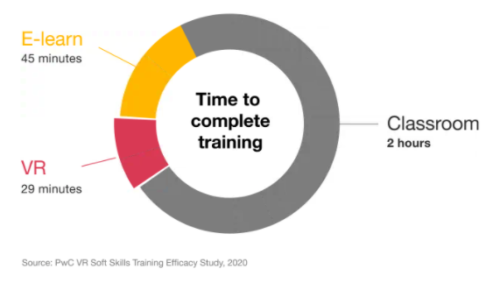
VR learners are more confident in applying what they’re taught, which is essential in the case of soft skills. What makes the difference in VR training is that learners can practice their skills in a controlled and safe environment.
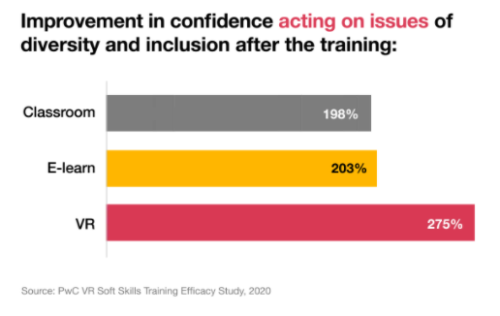
Employees are more emotionally connected to VR content, they understand and remember things more deeply as their emotions are involved. What we actually have here is a game changer for training.
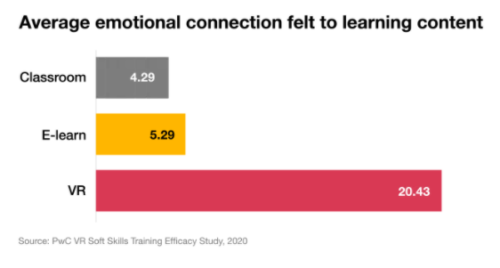
With VR learning, users are significantly less distracted. In a VR headset, simulations and immersive experiences command the individual’s vision and attention. There are no interruptions and no options to multitask.
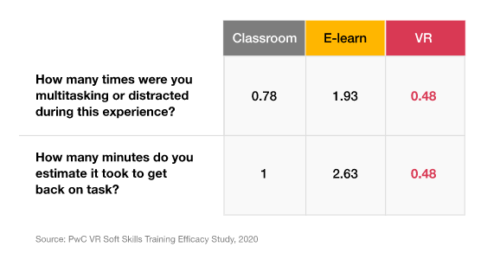
VR learning can be more cost-effective at scale. According to the PWC case study, At 375 learners, VR training achieved cost parity with classroom learning. At 3,000 learners, VR was 52% more cost-effective than classroom.
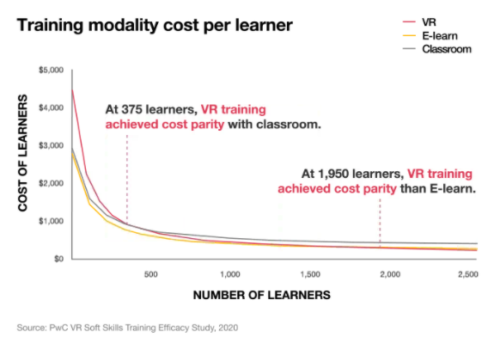
By the same token, in 2019, Prof. Spiegel and his team conducted extensive research, including a comparative experiment with a randomized sample of hospitalized patients. The hypotheses referred to the extent VR technology can significantly help in the treatment of chronic pain. The experiment took place on the Cedar Sinae Medical Center: the patients were randomly distributed in two groups. In the VR group, patients were asked to use the headset for 10 minutes in the presence of study staff to practice with the equipment, and then advised to use the headsets thrice daily, for 10 minutes per session, and as needed for breakthrough pain over the subsequent 48-hours. Patients in the control group were instructed to tune their television set to the “Health and Wellness Channel”, which is available in all rooms throughout the hospital. The programming includes guided relaxation content (e.g. yoga and meditation), discussions about health and wellness topics, and poetry readings. This practice also resulted positively in pain relief in previous research. The results confirmed the initial hypotheses that VR would have positive effect on pain relief. As they reported: “VR significantly reduces pain versus an active control condition in hospitalized patients. VR is most effective for severe pain. Future trials should evaluate standardized order sets that interpose VR as an early non-drug option for analgesia.”
Download our free e-book on corporate mindfulness and allow your team to be more.

While it sounds obvious, it is important to remind ourselves that businesses rely on the health of their
employees. Employee wellness programs improve not only employee engagement and productivity, but also
lead to strong brand awareness. Strong relationships between companies’ brand and its stakeholders have
become a primary source of competitive advantage. Great Place to Work certified companies are increasingly recognizing the importance of employee wellness.
Our business vocabulary corroborates this shift, with new terms like employer branding, brand love, brand trust etc. becoming the new “keywords” in business plans and on zoom meetings.
What we must do now, as managers and team leaders, is to align our approach towards our people with this new framework, in order to become the managers that we aspire to be. In other words, transactional leadership alone is not sufficient for business success. Motivation has replaced fear; empathy has replaced strict rules; retention has replaced turnover.
But what makes a good employer today?
The ability of managers to address what really matters to their employees and to create an inclusive, rewarding work environment is key. The more empowered and cared for team members feel, the more productive and devoted to their job role they become. Academic findings show satisfied employees pay more attention to detail, become better service providers and contribute positively to corporate image and word of mouth marketing.
In this context, taking action to boost staff’s mental well-being becomes self-explanatory: being individually balanced and calm is the cornerstone of team balanced performance. It is increasingly being recognized that the mental health of employees is a crucial determinant in their overall health and that poor mental health and stressors at the workplace can be a contributory factor to a range of physical illnesses like hypertension, diabetes and cardiovascular conditions, amongst others. In addition, poor mental health can also lead to burn-out amongst employees, seriously affecting their ability to contribute meaningfully in both their personal and professional lives. It is so important, that employers encourage employees to engage in mindful practices before they feel emotionally challenged.
When we started working on the Solas VR meditation app, prior to the Covid-19 outbreak , we knew how important the implications of corporate mindfulness were. By the time we launched the app, things had changed and remote work made joint team activities even more urgent: teams need to introduce new rituals that would enforce the sense of community, especially when working remotely.
Download our free e-book on corporate mindfulness and allow your team to be more.